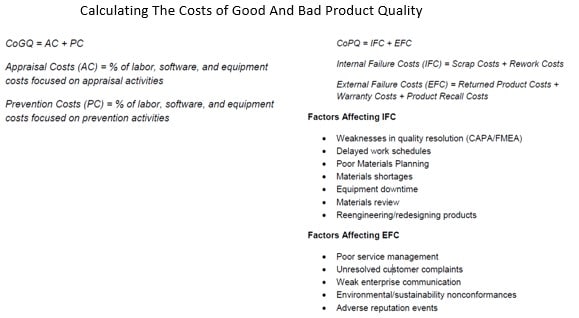
Bottom Line: Of the many quality management initiatives, frameworks and programs, knowing the Total Cost of Quality (CoQ) is becoming the most important as it provides insight into how well orchestrated supplier networks, quality management, manufacturing and service are.
Cost of Quality is an essential metric for translating the performance of supply chains and networks serving complex manufacturers into a monetary measure of performance.
Many A&D manufacturers rely on supply chains and diverse supply networks that are specifically developed to provide configure-to-order and engineer-to-order components, assemblies and products. Defining production quality levels and the costs associated with achieving supplier excellence for these highly customized assemblies is crucial.
In their study, Toward Integrating Cost of Quality in Supply Chain Network Modeling Castillo-Villar, Smith, and Simonton (2010) defined the cost of quality as “the sum of the cost incurred across a supply chain in preventing poor quality of product and/or service to the final consumer, the costs incurred to ensure and evaluate that the quality requirements are being met, and any other incurred as a result of poor quality (Castillo-Villar, Smith, Simonton, 2010).” Summarizing their research in the following graphic, the integral elements of the Cost of Good Quality (CoGQ) and Cost of Poor Quality (CoPQ) are compared.

Source: (Castillo-Villar, Smith, Simonton, 2010)
Five Factors Driving A&D Manufacturers To Excel At Total Cost of Quality
The five factors driving manufacturers to adopt total Cost of Quality today include:
- Cost of Quality represents a powerful measurement system that translates the implications of poor quality, activities of a quality program, and quality improvement efforts into a monetary language for managers.
- Cost of Poor Quality is essential for A&D manufacturers to track key suppliers with the lowest overall costs that include nonconformance estimates, variances and historical performance across a range of projects.
- Studies of complex supplier networks shows that up to 16% of the total costs of a project are hidden when Cost of Quality is not included (Castillo-Villar, Smith, Simonton, 2010). A&D manufacturers are beginning to realize that having greater visibility into Cost of Quality significantly improves Earned Value Management (EVM) over the life of a project.
- Modeling supplier networks with Cost of Quality data during initial planning and implementation leads to a reduction in noncompliance and corrective action costs and lost productivity (Castillo-Villar, Smith, Simonton, 2010).
- Forward-thinking A&D manufacturers are using Cost of Quality as a financial metric able to translate the operational terms of delivered goods’ quality to strategic metric which is related to such as net profit, productivity ratio, total cash flow time. In addition it is being used for tracking the impact of quality on customer query time, level of customer perceived value of product, delivery performance, and level of suppliers’ defect free deliveries.
Reference:
Castillo-Villar, K., Smith, N. R., PhD., & Simonton, J. L., PhD. (2010). Toward integrating cost of quality in supply chain network modeling. IIE Annual Conference Proceedings, 1-6.
